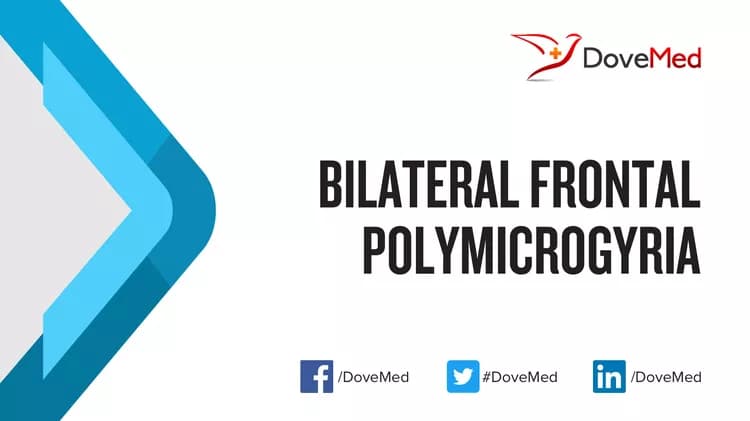What are the other Names for this Condition? (Also known as/Synonyms)
- Bilateral Frontal PMG
What is Bilateral Frontal Polymicrogyria? (Definition/Background Information)
- Bilateral Frontal Polymicrogyria is one of the rarest subtypes of polymicrogyria. Polymicrogyria is an abnormal pre-natal development of brain, which results in an increase in the number of brain folds or gyri
- Bilateral Frontal Polymicrogyria is a symmetric and bilateral form (in both brain hemispheres) that only involves the frontal lobes without including the area located behind the Sylvius fissure or the area located behind the Rolando sulcus
- Some researchers classify the condition into two different forms:
- Bilateral Frontal Polymicrogyria
- Bilateral frontoparietal polymicrogyria
- Signs and symptoms include delayed motor and language milestones; spastic (stiffness) hemiparesis (weakness in one side of the body) or quadriparesis (weakness in all four limbs of the body); and mild to moderate intellectual disability. Seizures may also be present
- The frontoparietal form is caused by changes (mutations) in the GPR56 gene but the cause for the frontal form of polymicrogyria is still not known
- Treatment is based on the signs and symptoms present in each person
(Source: Bilateral Frontal Polymicrogyria; Genetic and Rare Diseases Information Center (GARD) of National Center for Advancing Translational Sciences (NCATS), USA.)
Who gets Bilateral Frontal Polymicrogyria? (Age and Sex Distribution)
- Bilateral Frontal Polymicrogyria is a rare congenital disorder. The presentation of symptoms may occur at birth
- Both males and females may be affected
- Worldwide, individuals of all racial and ethnic groups may be affected
What are the Risk Factors for Bilateral Frontal Polymicrogyria? (Predisposing Factors)
- Currently, no risk factors have been clearly identified for Bilateral Frontal Polymicrogyria
It is important to note that having a risk factor does not mean that one will get the condition. A risk factor increases one’s chances of getting a condition compared to an individual without the risk factors. Some risk factors are more important than others.
Also, not having a risk factor does not mean that an individual will not get the condition. It is always important to discuss the effect of risk factors with your healthcare provider.
What are the Causes of Bilateral Frontal Polymicrogyria? (Etiology)
The exact cause of the frontal form of Bilateral Frontal Polymicrogyria is not known.
- Some cases of the frontoparietal form of Bilateral Frontal Polymicrogyria are known to be caused by mutation(s) in the GPR56 gene, which is also known as the ADGRG1 gene
- Mutations in this gene are inherited in an autosomal recessive manner
Autosomal recessive: Autosomal recessive conditions are traits or disorders that occur when two copies of an abnormal gene have been inherited on a non-sex chromosome. If both parents have an autosomal recessive condition, there is a 100% likelihood of passing on the mutated genes to their children. If, however, only one mutant copy of the gene is inherited, the individual will be a carrier of the condition, but will not be present with any symptoms. Children born to two carriers, have a 25% chance of being homozygous dominant (unaffected), a 50% chance of being heterozygous (carrier), and a 25% chance of being homozygous recessive (affected).
What are the Signs and Symptoms of Bilateral Frontal Polymicrogyria?
The signs and symptoms of Bilateral Frontal Polymicrogyria may include:
- Problems with swallowing
- Inadequate weight gain
- Speech impediment
- Cross-eyes
- Muscle weakness
- Paralysis of limbs
- Episodes of epilepsy
How is Bilateral Frontal Polymicrogyria Diagnosed?
Bilateral Frontal Polymicrogyria is diagnosed on the basis of the following information:
- Complete physical examination
- Thorough medical history evaluation
- Assessment of signs and symptoms
- Laboratory tests
- Imaging studies
Many clinical conditions may have similar signs and symptoms. Your healthcare provider may perform additional tests to rule out other clinical conditions to arrive at a definitive diagnosis.
What are the possible Complications of Bilateral Frontal Polymicrogyria?
The complications of Bilateral Frontal Polymicrogyria may include:
- Delay in reaching developmental milestones
- Problems with movement due to muscle weakness and/or paralysis
- Risk of falls and injury due to epilepsy
Complications may occur with or without treatment, and in some cases, due to treatment also.
How is Bilateral Frontal Polymicrogyria Treated?
Presently, there is no cure for Bilateral Frontal Polymicrogyria. The treatment is usually given to manage the signs and symptoms and any complication that develops.
How can Bilateral Frontal Polymicrogyria be Prevented?
- Currently, Bilateral Frontal Polymicrogyria is not a preventable condition
- Active research is currently being performed to explore the possibilities for treatment and prevention of such disorders
- Regular medical screening at periodic intervals with tests and physical examinations are recommended
What is the Prognosis of Bilateral Frontal Polymicrogyria? (Outcomes/Resolutions)
- The prognosis of Bilateral Frontal Polymicrogyria is dependent upon the severity of the signs and symptoms and associated complications, if any
- Individuals with mild conditions have better prognosis than those with severe symptoms and complications
- Typically, the prognosis may be assessed on a case-by-case basis
Additional and Relevant Useful Information for Bilateral Frontal Polymicrogyria:
The following DoveMed website link is a useful resource for additional information:
Related Articles
Test Your Knowledge
Asked by users
Related Centers
Related Specialties
Related Physicians
Related Procedures
Related Resources
Join DoveHubs
and connect with fellow professionals


0 Comments
Please log in to post a comment.